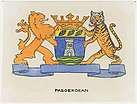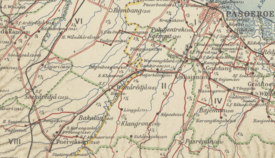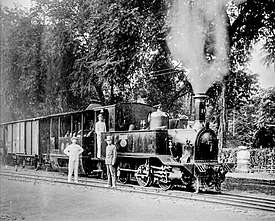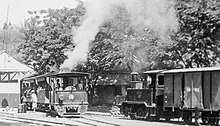Pasoeroean Stoomtram Maatschappij
The Pasoeroean Stoomtram Maatschappij, N.V. (PsSM, Dutch for Pasuruan Steam Tram Company) was a private tram company in Pasuruan on the Dutch East Indies (now East Java). It served passenger transport as well as goods transport of agricultural products such as sugarcane, tea and tobacco.
 | |
 | |
 Cockerill-Lokomotive C2201 Louisa, um 1910 | |
| Overview | |
|---|---|
| Headquarters | Pasuruan, Jawa Timur, Hindia Belanda |
| Locale | Pasuruan |
| Dates of operation | 1896–1988 |
| Successor | Kereta Api Indonesia |
| Technical | |
| Track gauge | 1,067 mm (3 ft 6 in) |
| Length | 48.5 kilometres (30.1 mi) |
History
The Pasoeroean Stoomtram Maatschappij (PsSM), operating as a tram company, proposed to the Government of the Dutch East Indies the construction of a rail network to solve the transport problems of the sugar mills in the Pasuruan area, which hindered the export of agricultural products. The sugar factories were among others Sf. Kedawung, Sf. Bekasi Oost, Sf. Gayam, Sf. de Goede Hoop, Sf. Pleret, Sf. Wonorejo and Sf. Alkmaar[1] [2] [3]
After the necessary negotiations, PsSM received the concession from the Dutch East India Government. Then it began in 1893, as follows, to open a tram rail network:
- Based on Government Resolution No. 2 of March 18, 1893:
- Pasuruan - Warung Dowo (6 km) was inaugurated on May 21, 1896.
- Pasuruan boom (2 km) was opened on December 27, 1896.
- Based on Government Resolution No. 37 of August 29, 1895:
- Warung Dowo - Bekasi (Winongan) (10 km) was opened on March 26, 1897.
- Wonorejo - Bakalan (4 km) was opened on June 7, 1897.
- Warung Dowo - Wonorejo (11 km) was opened on 17 March 1899.
- Bakalan - Alkmaar Market (4 km) was opened on May 8, 1900.
- Based on Government Resolution No. 19 of June 17, 1911:
- Pasuruan - Gembong River (3 km) was opened on March 27, 1912.
- Warung Dowo - Ngempit (5 km) was opened on 1 December 1912.
 Chinatown (Jalan Niaga) in Pasuruan from Soekarno to Hatta Road
Chinatown (Jalan Niaga) in Pasuruan from Soekarno to Hatta Road Traffic light over the intersection in the Hoofdstraat of Pasuruan
Traffic light over the intersection in the Hoofdstraat of Pasuruan Wayside halt with Hohenzollern tram
Wayside halt with Hohenzollern tram Warung Dowo station with steam locomotive B16
Warung Dowo station with steam locomotive B16
Track construction
| Name of the line | Line | Name of stations and halts | Opening date | Track length (km) | Remarks |
|---|---|---|---|---|---|
| Jalur kereta api Pasuruan–Warung Dowo | Pasuruan-Warung Dowo | Stasiun Pasuruan Halte Pasuruan Pecinan Halte Pasuruan Alun-Alun Halte Pasuruan Bui Halte Kebonagung Halte Rogoitan Halte Pohjentrek Halte Pleret Stasiun Warung Dowo | 21 May 1896 | 6 | Closed on 1 February 1988 |
| Jalur kereta api Warung Dowo-Winongan | Warung Dowo-Bekasi Oost (Winongan) | Stasiun Warung Dowo Halte Pengkol-Halte Keboncandi Halte Gayam (Pasuruan) Halte Wonosalam Halte Tenggilis Halte Kletek Halte Penataan Stasiun Winongan | 26 March 1898 | 10,5 | Closed on 1 February 1988 |
| Jalur kereta api Warung Dowo–Sengon–Alkmaar | Warung Dowo-Sengon | Stasiun Warung Dowo Halte Wangkal Halte Klojen Halte Gambiran Halte Kurung Halte Pacarkeling Halte Areng-Areng Halte Kluwut-Stasiun Wonorejo Stasiun Blimbing (Pasuruan) Halte Bakalan Halte Procong Stasiun Sengon | 8 May 1901 | 23,5 | |
| Jalur kereta api Warung Dowo–Sengon–Alkmaar | Sengon-Alkmaar | Stasiun Sengon Halte Procong Stasiun Alkmaar | September 1901 | 3,5 | |
| Jalur kereta api Warung Dowo-Ngempit | Warung Dowo-Ngempit | Stasiun Warung Dowo Halte Susukan Halte Plinggisan Halte Sedodol Halte Mojoloro Stasiun Ngempit | 1 December 1912 | 5 | Closed in 1932 |
Locomotives

For operation, the PsSM 1900 imported five steam locomotives B16 08-12 from the Hohenzollern Locomotive Works, two C22 steam locomotives of the 1894 01-02 series from Cockerill, and one of the 1911 03 series and 1921 a steam locomotive D12 (series 01) of Hanomag. The Cockerill locomotives were unusual, because they had an inside frame for the first two axles and an outside frame for the third axle. This provided more space for the firebox between the wheels but required very long crank pins on the inside framed wheels of the first two axles.
The steam trams facilitated the daily commute for the working people. Therefore, the tram quickly received a good response from the population, which used at that time otherwise traditional means of transport such as horses or carts. Despite the cheap prices, the tram was considered faster than other means of transport this time.
The locomotives were used not only for passenger trains, but also for freight trains that transported sugar and other export products to the port.
 Cockerill steam locomotive C22 in Chinatown (Jalan Niaga) of Pasuruan, 1929
Cockerill steam locomotive C22 in Chinatown (Jalan Niaga) of Pasuruan, 1929 Cockerill locomotive C2201 Louisa, ca 1910
Cockerill locomotive C2201 Louisa, ca 1910 Locomotive B16 crosses the river
Locomotive B16 crosses the river._It_became_PJKA_B1611.png) Locomotive B17
Locomotive B17
Closure
Over time, the tram was partially shut down by the PsSM, because it was not able to compete with the increasing road transport due to the aging of rail vehicles and infrastructure. Some sections were closed during the Japanese occupation. In the decade of 1970-1980, the construction of roads was carried out on a large scale along with the increase of road traffic. The decommissioning took place as follows:
- Pasuruan Boom (port) was shut down 1943/1944 by the Japanese
- Warungdowo - Ngempit was decommissioned in 1943/1944 by the Japanese
- Warungdowo - Wonorejo was shut down in 1976
- Pasuruan - Winongan was shut down by the Japanese, but later put back into service, because many sugar factories were still in operation. However, on February 1, 1988, this route was finally shut down.
References
- Subarkah, Iman (1992). Sekilas 125 Tahun Kereta Api Kita, 1867-1992. Perum Kereta Api.
- Santoso, Roesdi. Kereta Api dari Masa ke Masa.
- Oegema, J.J.G. (1982). De Stoomtractie op Java en Sumatra. Kluwer Technische Boeken B.V., Antwerpen.